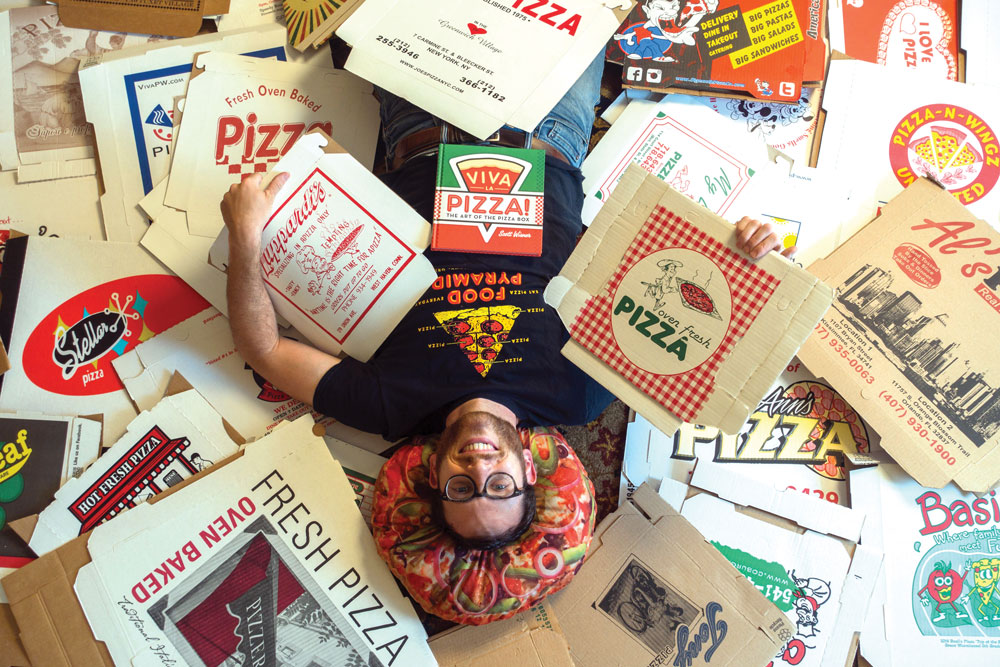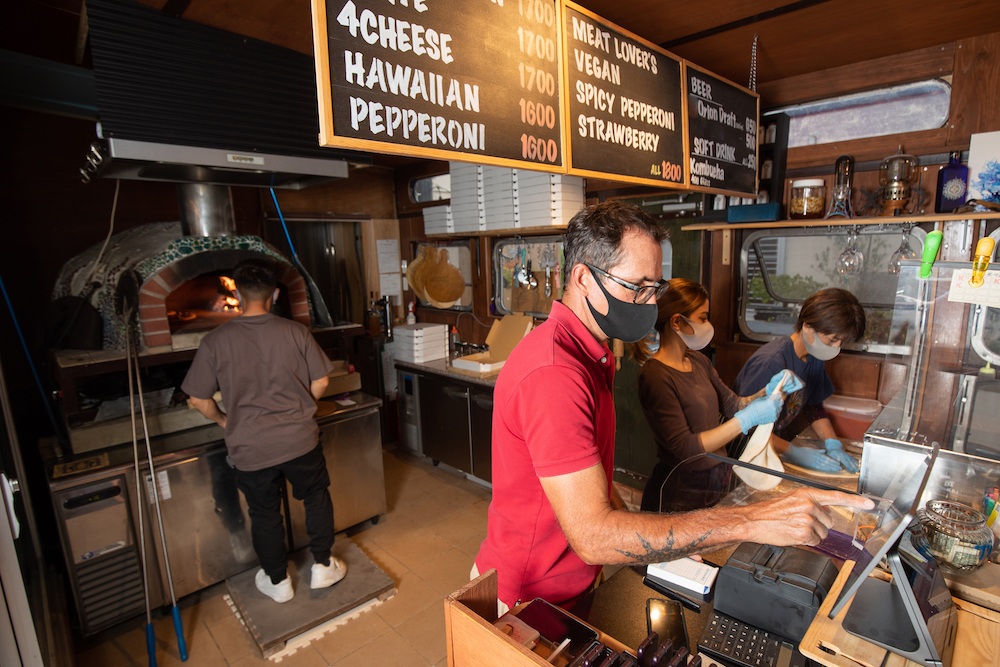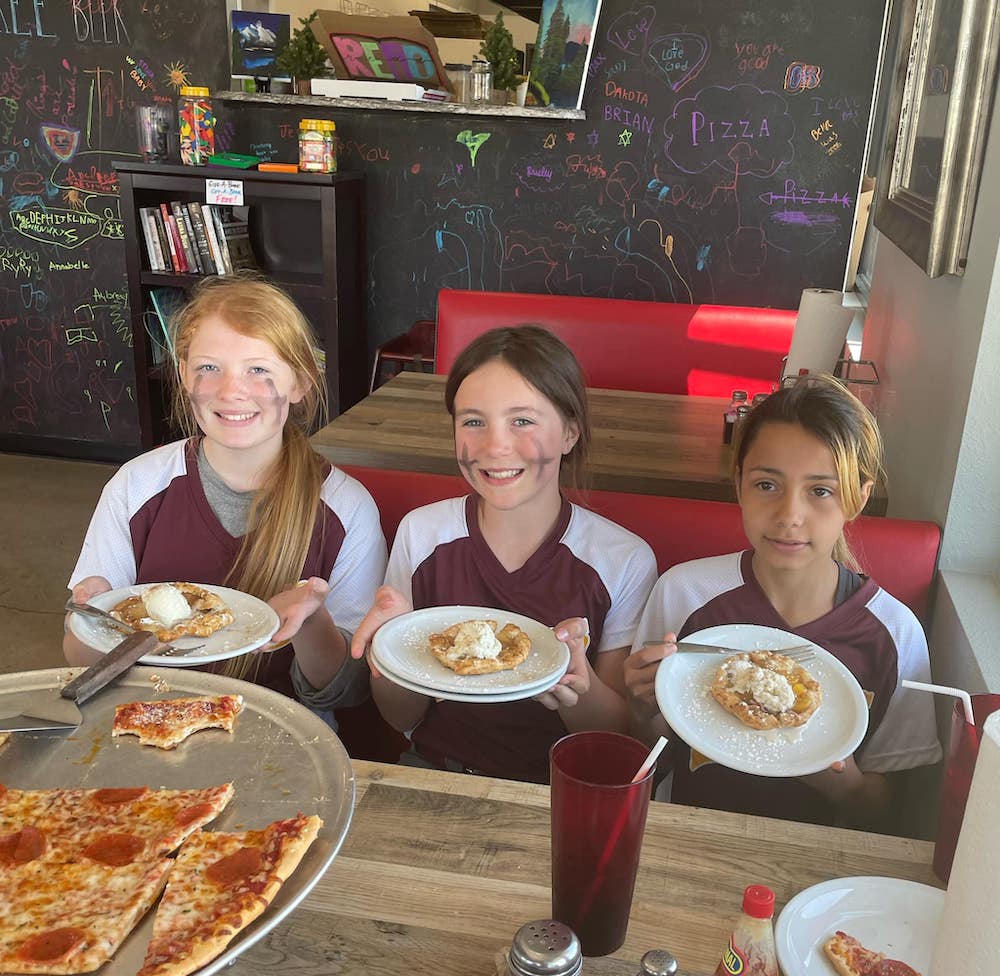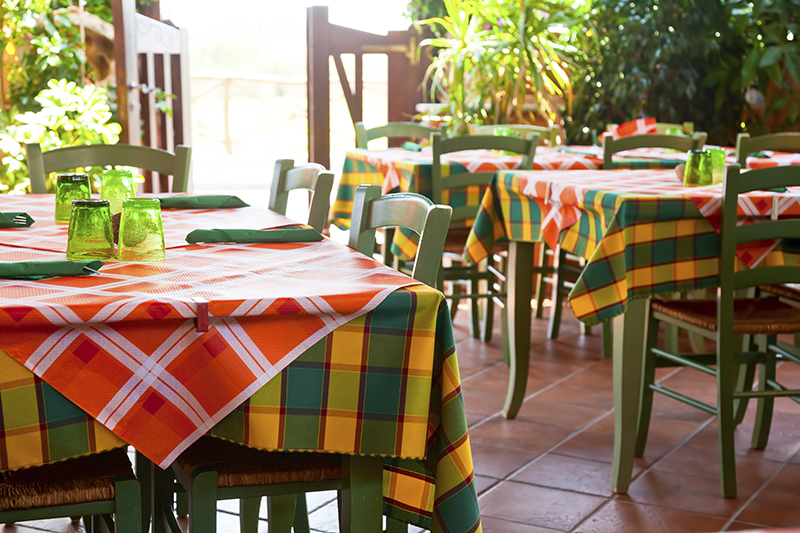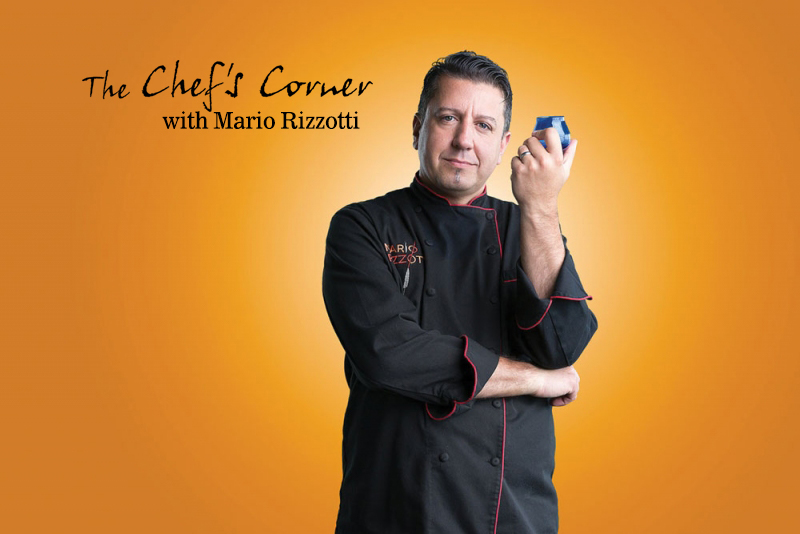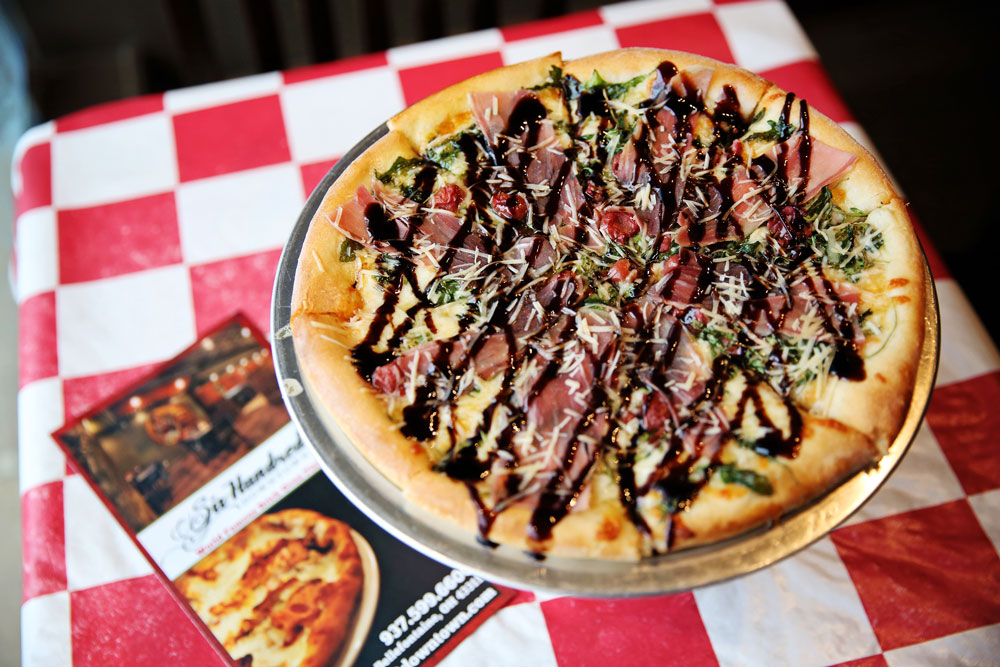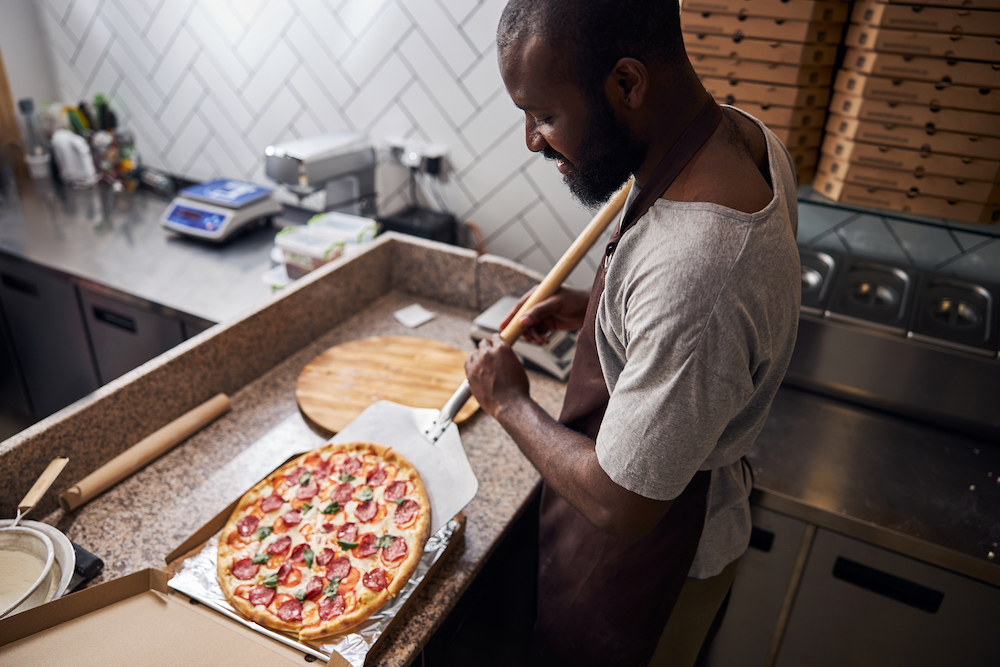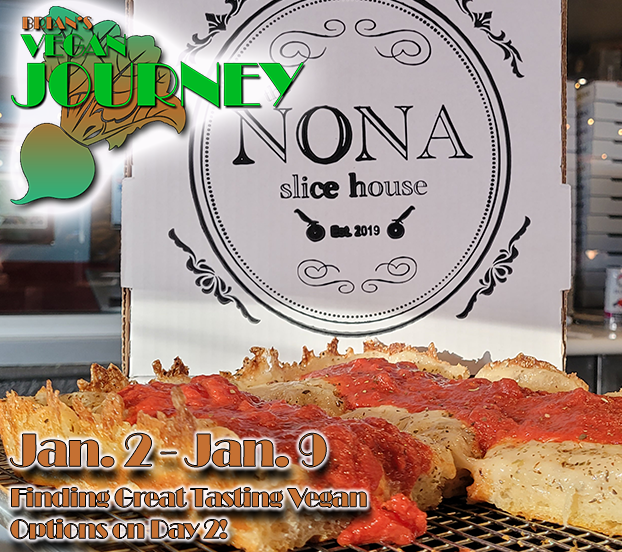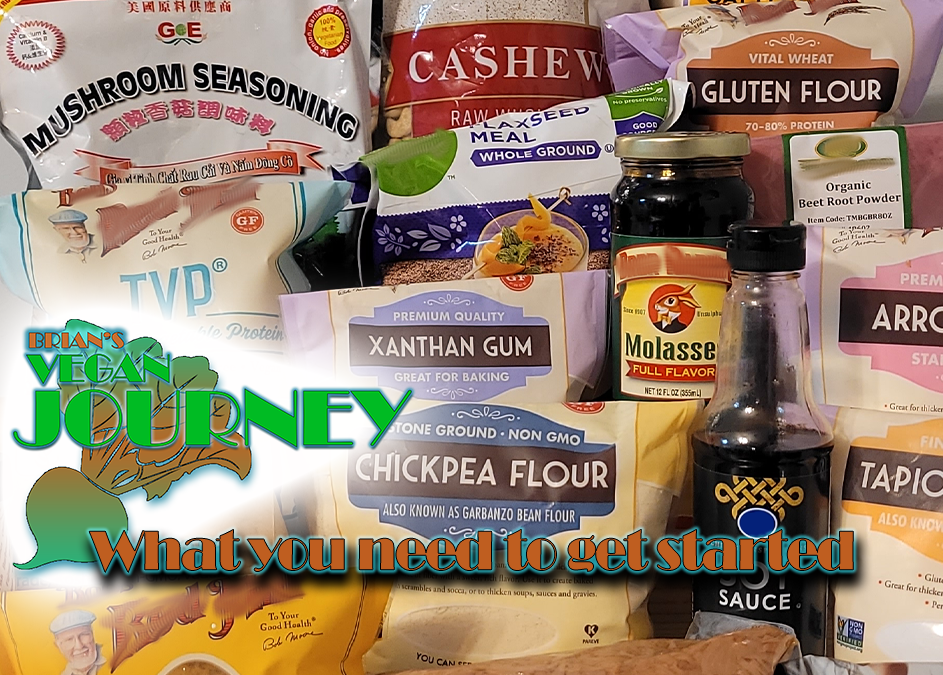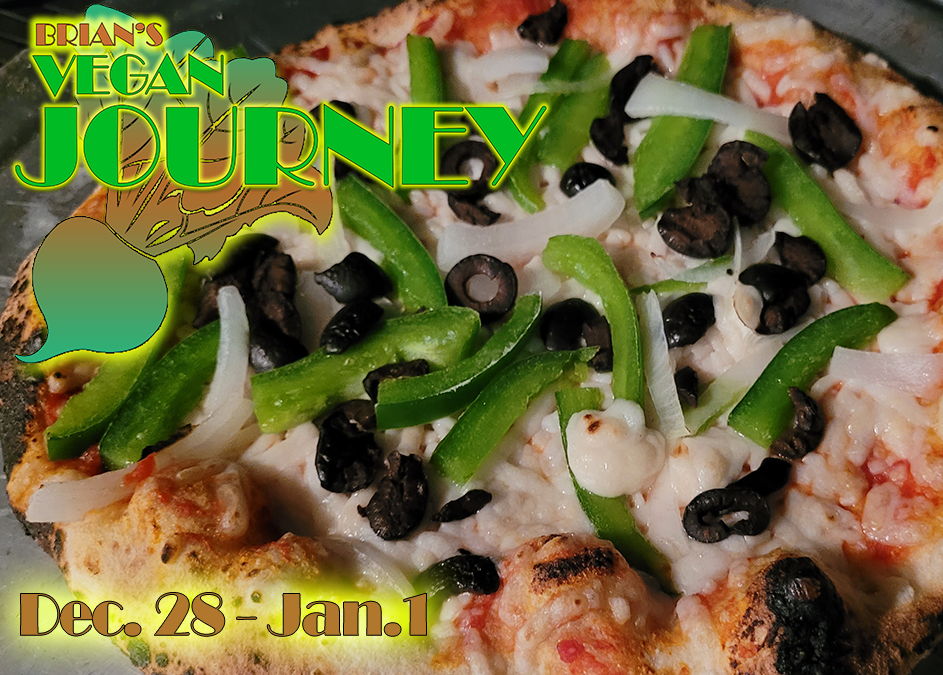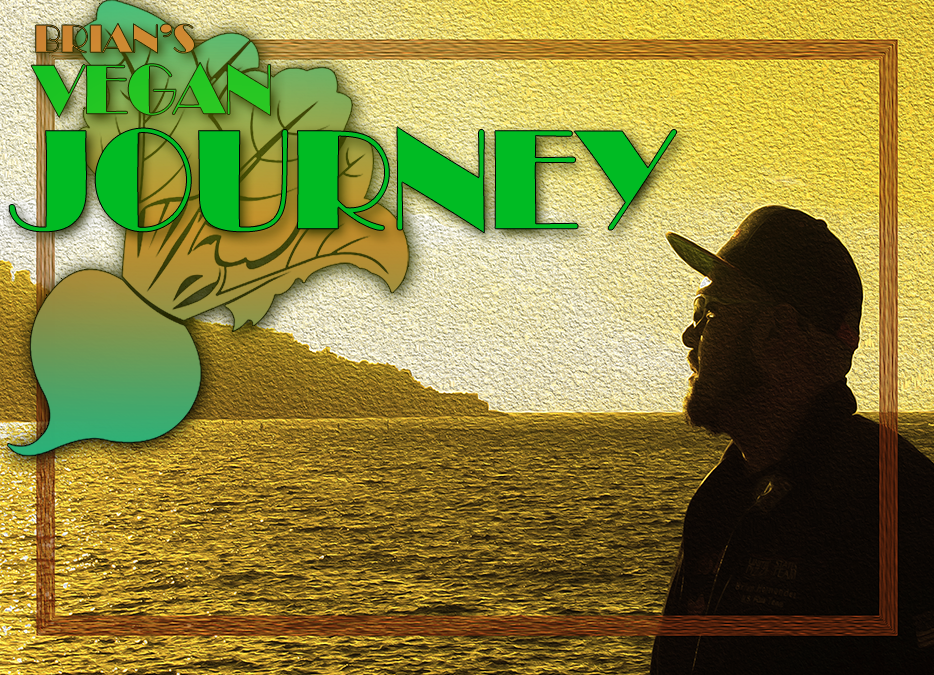If you passed him on the street you probably wouldn’t recognize him unless you knew him. Under the glasses and beard, he looks like any regular New Yorker on his way to work or play. Now, if you saw him getting off his signature yellow school bus in front of a New York pizzeria, followed by a gaggle of pizza-eyed tourists, you would get it right away. “That’s Scott of Scott’s Pizza Tours!”. It’s like seeing pizza royalty walk among the commoners. Or at least a walking pizza encyclopedia. Now even though Scott is rumored to be listed as GQ’s Sexiest Man on Earth 2017, and does 500 push-ups a day (all reported to us from the office of Scott Wiener, ESQ.), he still somehow managed to find the time to sit down with me and have a conversation about tours, recipes, records and pizza in general.
Brian: I’m sitting here the infamous Scott Wiener of Scott’s Pizza Tours in New York. Thank you so much for spending a little time with me in the Chef’s Corner. How are you doing today Scott?
Scott: I’m feeling quite infamous. Thanks for having me here today Brian.
Brian: We met in Atlantic City when you emceed the Slice of the Northeast competition in 2012. I remember you riffing for what had to be hours about pizza, the history, the trends and just random pizza trivia. I was impressed. How did this obsession begin for you? What is your earliest pizza memory?
Scott: I don’t remember ever discovering pizza. It was always just there. Memories of sitting in the car, the smell of the pizza and the cardboard, and the thrill of it, “We’re getting pizza when we get home!”. It just had a warmth that was physically inspirational to me.
Brian: So, the cardboard itself had a big impact on your earliest pizza memories? Just the smell of the pizza boxes?
Scott: Absolutely. Pizza always came out of a box. We would go out for pizza sometimes, but more often, we would bring it in or get delivery. So, the pizza box was part of the whole excitement.
Brian: Now did that lead to your obsession with pizza boxes? I heard you collect them.
Scott: I do not think that the experience of handling pizza in a box is what directly led to me collecting pizza boxes, and having a world record for it, but who knows. Maybe subconsciously that trigger was there.
Brian: You mention the world record for pizzas boxes. That’s a Guinness World Record I assume?
Scott: Absolutely. A Guinness World Record largest pizza box collection. In 2013, I had over 600 pizza boxes, and that was a world record. I’ve kept collecting over the years and now I have over 1300, and I don’t think anyone else out there is really collecting them at all.
Brian: That is very impressive. So, “Scott’s Pizza Tours”. How long has this been around?!
Scott: I’ve had my tour business since the Spring of 2008, at this moment right now, we are 9 ½ years old.
Brian: How did you decide that giving pizza tours was what you wanted to do?
Scott: It was totally weird. I used to go with my friends to pizzerias for fun. Not uncommon in the New York area. I started meeting tons of people saying, “Oh, I’ve been doing pizza crawls for 20 years”. I was facetiously like ‘Yeah…ok, cool”. You just go around, eat a lot of pizzas, then go home and take a nap. But that all started to change on my birthday 10 years ago. I rented a school bus, invited a bunch of friends and said, “Let’s just drive around town and eat pizza”. It was so much fun I decided to keep doing it.
Brian: Well the next question I guess would be, why just pizza tours? Did you ever have any ambition to go into the pizza business for yourself?
Scott: The pizza industry had never, and still doesn’t truly interest me, for myself I mean. I don’t want to own a pizzeria. I love making pizza, but on a small scale. It really became more about celebrating pizza. I thought to myself, “Can I make a living being a pizza fan?”, and that’s what this is. I just love pizza. I never really thought about tours at first. I thought about what could I do? Should I blog? Write a book? Take pictures? There was no Instagram back then. We were only a few years into food blogging, but I didn’t have an internet connection at the time, so I couldn’t do that anyways. Then I thought, “what’s good medium to tell these stories?”. Tours just seemed right. There are tons of tours in New York. I met a lot of people who do food tours, and I started going to meetings of the Tour Guides Association. Then I studied to take the test to get my Tour Guides License. I failed it the first time. I took it again and I passed. That’s when I started “Scott’s Pizza Tours”.
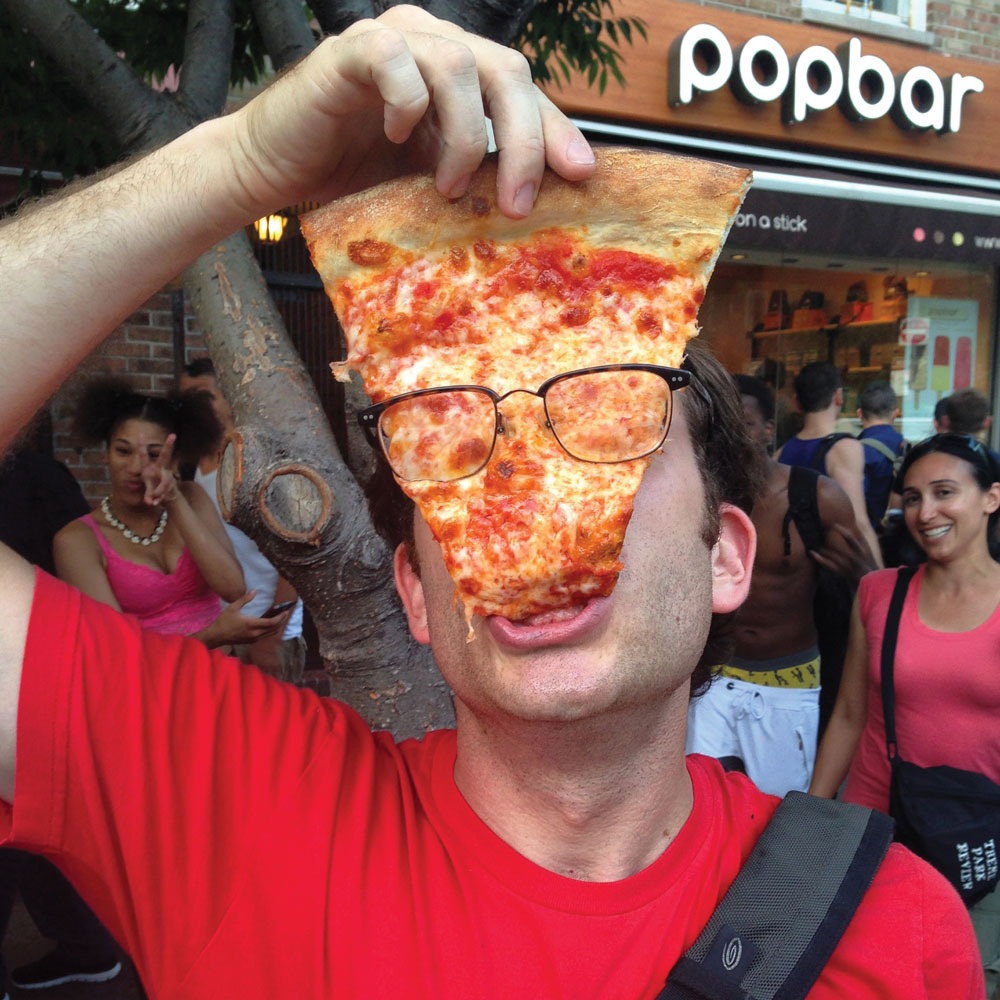 |
|
Photo by Robb Alvey |
Brian: After ten years of doing these tours, I know you’ve been to a lot of pizzerias numerous times. What are some mistakes you notice as a consumer that can help out anyone getting into the business?
Scott: The bigger mistakes tend to be made by the established pizzerias. They often say, “I’ve been doing this for 20 years, I know what I’m doing, don’t change anything”. Then you see the new ones come along, the little whipper-snappers, and they are better in a lot of ways. They’re paying more attention to the consumers. They’re less concerned with only dealing with the bottom line. When you’re a new place it’s all about passion, and most owners know they are not going to make a dime for at least a few months, maybe even a year or two. New places are utilizing social media to help spread the word of mouth. Using Instagram to showcase successes and mistakes on the menu. I have people on my tour, that when we stop at a certain place, they’ll say, “Oh, that’s the pizzeria with the funny shaped pizzas I saw on Instagram”, or something to that effect. The older pizzerias tend to not have as much social media presence. I’ve seen them doing things like having too much bench flour, or an inconsistent bake. There’s just too much flour on the crusts sometimes, it really affects the taste. But you don’t want to tell them what to do. They’d just say, “That’s just how we do it”.
Brian: Are there any particularly good ideas you’ve seen from the established pizzerias?
Scott: I find the older places are a little more resistant to technology, which is ok. If you’re client base is also resistant to the technology, then you’re fine. If your pizza boxes have the tabs in the corner that say, “Save ten of these for a free pie”, that works. It’s a loyalty program for the analog world. You can’t expect someone in their early twenties to save a lot of little cardboard pizza box coupons, but you could expect, say, someone in their early seventies to be all up for it, and they’re very excited to get that free pizza after they save 10 pieces of cardboard.
Brian: That makes me feel old. I’m not quite 40 yet, but I would totally save ten of those. So, you think loyalty programs are a good thing for independents to start up?
Scott: Definitely. It’s all about loyalty. Consumers shop for food in few different ways. Some shop for taste, and good luck if they do, because all you have to do is make one bad pie and that’s it, unfortunately. They do it for value. “What’s the lowest price I can get for the most volume of food?”, and when you start shooting for that, you’re not shooting for the stars, you start shooting for the toes. So, you could do that, and you could be in business for a while, but then you can’t expect people to be coming to you for taste. Sometimes people look for speed. They always say you can things cheap, hot and good. It’s hard to hit all 3. You really have to pick 2 of those. But if you can hit the trifecta, then Hazaah! You’ve got it made!
Brian: You’ve established a well-known and long-standing business there in New York. What is one of your biggest success tips you can let our readers know about? Maybe something they can apply to their own businesses.
Scott: My #1 tip is to definitely allow yourself to “get obsessed”. Whether it is the décor, quality of the product, speed of service…allow yourself to become totally obsessed with it and understand it. Because when you do, you become open to more opportunities and more ideas. For my business, I allow myself to get really into it. The more I get into it, the more the press picks up on it. If you stay quiet about how into your business you are, well, that’s just not a great idea. The more people know about and talk about you, the more they are doing your promotion for you.
Brian: That leads to another question I had. How do you do your advertising? Is it social media, print ads, radio or is it all word of mouth?
Scott: It’s all word of mouth. I haven’t done a single ad since maybe 2009 or 2010. I spent $600 once on a promotion where you can put little cards in hotels. That didn’t work. I went to check all the hotels and none of them had the cards. I realized that I wasted that money, but after that, it’s all word of mouth. People who love you will tell all their friends that they think will love you, and you’ll get nothing but good things walking through the door. The problem is, if you put it out to the world without any process of refinement, you might be setting yourself up for people who might not like your product.
Brian: It’s been 10 years now. How many pizzerias did you start with on the tours and how many do you have now?
Scott: When we first started the tours, maybe there was a batch of 10-12 pizzerias in our stable. Now there are 50-60. We’re hitting more neighborhoods with a wider spread now. And each tour is different. It varies on my crowd. At any given point, I really only know the first pizzeria we will hit. It changes on the geography of our guests. If I have a group from Wisconsin, I will hit some Neapolitan and New York slice places. If I have a native New Yorker, I will look for some Midwest style pizzerias. I try to give each person a taste of what they haven’t had before.
Brian: So, pizza making. You’ve been around it for a while learning at the hands of the greats. What is one ingredient you will never use?
Scott: Ooh, I honestly don’t think there is a single ingredient I would never use.
Brian: Not even Pineapple?
Scott: I’m way into Pineapple. It’s delicious. If you don’t like it, don’t eat it.
Brian: Hazaah! We’ll give a virtual high five on that one. So, there is no ingredient that makes you cringe?
Scott: Look, I’m not that big on broccoli, but if you chop it up really fine, and have done something creative with it, of course I’ll eat it.
Brian: What a very progressive attitude on that subject. I love it. On a similar note, what is one ingredient you haven’t played with you would like to get your hands on?
Scott: You know, I’ve never got my hands on a bunch of peppadew. I never do peppadew. I’ve had them a few times, they’re sweet, they’re rich.
Brian: What would you do if you got some peppadew?
Scott: I’m thinking, a peppadew, post oven prosciutto with a ricotta cheese and maybe a lemon zest on top. You know, sweet, salty, acid. I just want to play with it. I really like trying things that are different. A sausage and garlic pizza is great, but it’s nothing you haven’t seen before.
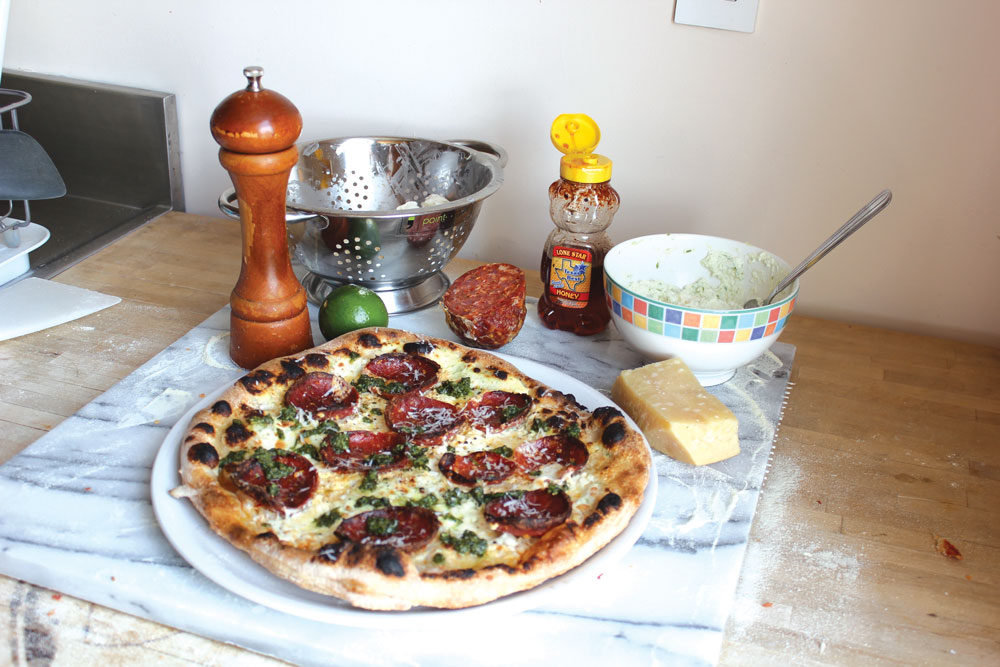 |
|
Click to check out Scott's own pizza creation (complete with recipe video), the Mo-Heato! |
Brian: Have you ever had a pizza industry job? Been a cook or delivery driver?
Scott: I did work at a couple of pizzerias, but only for short term. Most of it was while I was running the tours. My friends who owned pizzerias would say, “Hey, if you want to get any more experience, come in and work any time you want”. So, I would go in and work, but I’ve never had that quintessential high school or college job at the pizzeria. It’s been more to just get a fun experience myself.
Brian: Well, not to be rude, but how does someone with your limited experience working in the industry, become so knowledgeable about that industry and the history of pizza?
Scott: Well, the history was the easier part. I just paid attention and researched it. There were a few books out there when I started about pizza history, not that many, but I would read them. I’d find something interesting and then research that as well. What else can I get from that source? A story, a picture? That’s what led me down the rabbit hole. For my tours I thought, I can’t just take people to Lombardi’s, I should show them some old pictures of the pizzeria, frame the history. Then when you track down the old pictures you start asking more questions. From there you just start digging more. It gets deep. I still research all the time. If I’m knowledgeable about pizza, it’s because I just keep researching. And after years of doing the tour now, we get mostly pizza nerds and professionals. People who want to see how the operations work and learn about the business. Not just eat pizza. I tell people “If you want to just eat pizza in New York, here’s the list on my website. If you want to learn about pizza, come on a tour.”
Brian: Who was the first big name pizza player you met in New York?
Scott: First one would have been John Brescio, the current owner of Lombardi’s, the oldest pizzeria in New York. I went in there and talked to him for a bit about their history. I really got more resources than anything else. That was a big one, because after that, it gave me better questions and ideas to approach the other big pizzerias with. Patsy’s, John’s of Bleecker Street, Keste, Don Antonio by Starita, all these spots. From there it spread to knowing someone at pretty much every great pizzeria in New York. I know most of them.
Brian: Building off that, I’m seeing you now working with the likes of John Arena, Roberto Caporuscio, Giulio Adriani, Tony Gemignani working on this Caputo Americana flour. Is that right? How did that happen?!
Scott: John Arena is my Yoda, my mentor. When I first met him, right away I knew I had to listen to everything this guy says. Giulio Adriani, same thing. I’d get into conversations with him in his pizzerias in New York. We’d get into some great debates. Same with Tony G. It’s a good question as to how I became part of that crew. Caputo called me up and knew I eat pizza everywhere and I am based in New York. They wanted to make a flour product for New York style pizza. They thought, “Well, we need someone who knows what it tastes like and knows what it looks like”. I’ve actually known them (Caputo) for years. I’ve been to their mill a couple times. I’ve just known them forever. So, I think they figured, “Well, let’s just call up Scott”.
Brian: You’ve been to the Caputo mill?
Scott: Oh yeah, a bunch of times. Look, I do tons of research, and if I talk about something, I want to know as much as I can about it. So, if I tell you about a buffalo farm, and show you a picture, that buffalo, that means that I was on that farm and I took that picture. If I tell you about tomatoes, that means that I’ve picked and ate those tomatoes. It’s really important for me to do that. So, if I talk about flour on a tour, I have been to the mill and seen the process. Believe me, I was star struck to be on that (Caputo) team, but at the same time, they were all people and places I was familiar with through my last ten years doing the tours. It was fun to be a part of that group and represent all those people. But as far as pizza goes, I’m more interested in the dough. For me, it’s all about that crust, and every time I make pizza I don’t really care about what’s on top. It’s more about “Did the crust come out ok? Is it flexible enough? What are the variables I can change to make it better?”. After that, I can deal with funky toppings.
Brian: So, let’s try something Scott. You sound like you are very open to all ingredients. I don’t buy it. Let’s play the “Scott’s Lightning Round”. I’m going to throw some toppings at you. Tell me whether you would use them and what you would do with them.
Scott: Bring it on. I used to have lightning bolt sideburns in college!
SCOTT’S LIGHTNING ROUND!
Brian: Anchovies!
Scott: Absolutely use them. I’ll take those anchovies and mash them down and make them into a paste. Then I’ll put some tomatoes on top of that. Then I’ll add little dots of mozzarella. Then cover it in Parmigiana Reggiano. Bake that, then hit it with some olive oil when it comes out. Then those anchovies are like, they’re like, ghosts in the distance, haunting you.
Brian: Brussels sprouts!
Scott: Oh, most definitely. I’ll roast them up a little bit first, but just a little. After about 5 minutes, I’ll gently break them apart and throw them on the crust. Then, I guess the classic pairing would maybe be with pancetta or some kind of fatty meat on a white pizza, with some garlic too. I’d add the broken-up sprouts, then break up the fatty meat, like a raw sausage, over it. As it cooks, all that fat will render into the pie and add all that flavor, but it will also help protect the sprouts from burning.
Brian: Caviar!
Scott: I’d have to do that after the bake, and most likely on a white pie. It’s pretty salty, I wouldn’t want it to conflict with acid from tomatoes. I would slice the pie first, then put a little tiny dollop of caviar on each slice. That seems kind of obvious, but whatever. I’ll do it anyway, I’m not a professional pizza maker. I got nothing to prove!
Brian: Ok, I have to ask about one more…pineapple!
Scott: Pineapple! I’d cut the pineapple in half, probably roast that first at a low temperature for a long period of time. I’d want to get it really loose so I can take a fork to it. I don’t want to just put slices on a pie. I want to razzle dazzle it! You know what I mean? Then put some kind of fatty pork on top, as well as something hot. Some kind of pepper maybe. Jalepeno is kind of obvious. Or maybe hit it with some spicy honey! Then you have the sweet, the hot and the salty. A nice trifecta.
Brian: That was insane Scott! I think I will make the Scott’s Lightning Round a regular thing in the Chef’s Corner with future guests. So back to the tour really quick. What’s your personal favorite stop on the tour right now?
Scott: I don’t know that I have a single favorite stop. Describe my group for a three-stop tour.
Brian: Midwest tourist, Indiana, Ohio area. There’s somebody from southern California. Then you have someone from Atlantic City.
Scott: I like that. You can’t prescribe the medication until you know the condition. I would say, for this group, I would start at a place called Brunetti Pizza, a nice place in the West Village. The California person will be psyched about that. It’s a light pizza. A Neo-Neapolitan pizza with interesting topping combinations. But then the mid-westerner will be like, “I did enjoy that, but, it was a little light”. Then I’ll respond, “Don’t worry, because we’re going to John’s of Bleecker Street next. It’s been around since 1929, it’s hearty, the cheese is first, it has a great chew, and you’re gonna have a great night”. Actually, the Atlantic City person would enjoy that too. Then after that. I might go to Joe’s Pizza on Carmine St., because it’s a traditional New York slice joint with big slices, hanging off the paper plates. I think that would be the ultimate tour. I don’t like to duplicate oven types on the tours. With John’s being coal fired, and Brunetti being wood, Joe’s rounds it out with the good ole’ fashioned New York Style.
Brian: Who is one living person in the industry today you haven’t met or worked with, but really want to?
Scott: I have never met or spent time with Chris Bianco. That’s the man. I feel like I’ve met some of the other big dogs, but I would really love to be able to spend some time with Chris Bianco and absorb some of his mojo. He really has focus on what he’s doing. He also thinks about things in ways other people have forgotten how to think about things. He’s about the mind set of “I’m going to use these simple things, and I’m going to use them right”. I would love to absorb that.
Brian: He’s definitely on my list too. I would love to get Chris into the Chef’s Corner. Let’s move to a trickier question. Who is one legend in the industry you wish you could have met or learned from?
Scott: Without a doubt, I would want to meet Antonio Pero of Totonno’s Pizza at Coney Island. One of the first pizza makers in America. He got his start at Lombardi’s. I would just love to talk to him about what was going on at the time, because at the time, pizza wasn’t a thing. I wonder how important it was to him and what his background was in it. It would just be fascinating.
Brian, Scott, I cannot thank you enough for this great interview. You are a huge part of our industry, and I really appreciate the time you took to let us see what it’s like inside your brain. You are the biggest Pizza Nerd out there, can I call you that? We’d love to have you come visit our test kitchen.
Scott: You can call me whatever you want. I’d love to visit. I’ve never been to Oxford.
Brian: Well, I am in awe of your knowledge of pizza, the industry and history. As always, a class act! Thank you Scott.
For more information about Scott Wiener and his pizza tours, please visit scottspizzatours.com

